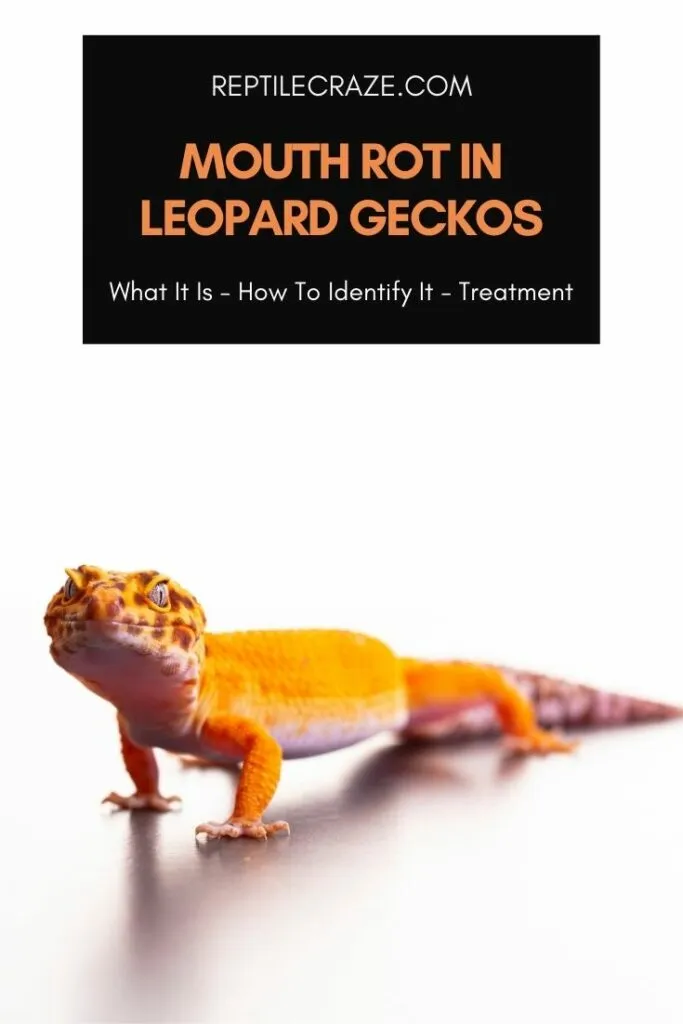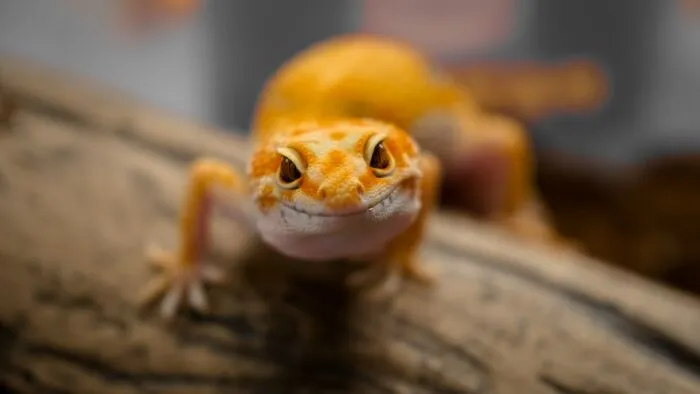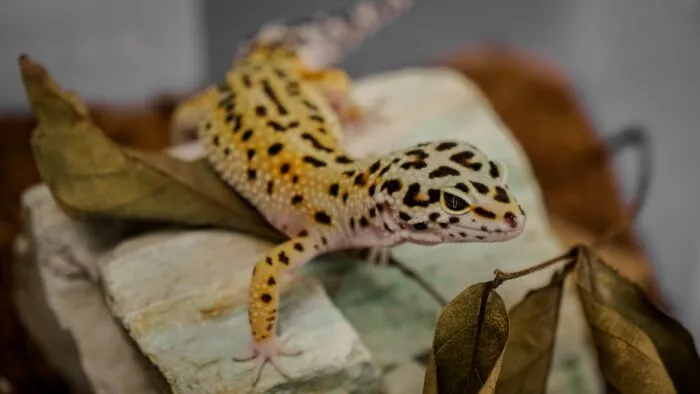
Having a leopard gecko as a pet can be fun and rewarding. But like all pets, they have their own set of challenges and health issues. The more knowledge and understanding of your leopard gecko you have the better you can ensure it has a happy and healthy life!
Mouth rot, known as infectious stomatitis, is a bacterial infection of the mouth that leopard geckos can suffer from if experiencing stress or as a result of trauma. It is infectious and occurs when the immune system is under stress, causing the balance of bacteria in the mouth to be disrupted. It can cause serious consequences if not treated.
In this article, we will explore a common leopard gecko health issue of mouth rot, the causes and how to prevent them, the signs and how to recognize them (with video), and treatment (with video) and the products you need for it.
Table of Contents
What is mouth rot in leopard geckos?
Mouth rot is a contagious affliction so if you suspect a case of mouth rot in your leopard geckos it is very important that you isolate them away from any other reptiles. Use separate cleaning equipment and wash your hands thoroughly before and after servicing their
Mouth rot is not transferable to humans nor any of your mammalian or avian pets so there is no cause for concern and you do not need to shy away from spending time with your leopard gecko.
If your leopard gecko does have a case of mouth rot be aware that it will be under stress and quite uncomfortable so it is preferable to keep handling to a minimum as not to exasperate their stress levels!
Mouth rot usually occurs as a secondary infection to another stress to the leopard gecko. This can sometimes be hard to identify so part of good reptile husbandry is to keep great records and notes.
It is best to keep records of temperatures, humidity, feeding, and defection to help you identify patterns and changes. This will help you and your vet understand what is truly going on if something is not quite right!
Note: If you fear that your leopard gecko might have mouth rot, it is best to bring it to a vet asap. If you don’t live near a reptile vet, get help from an online vet. An online vet can tell you if it is really mouth rot, and what you can do to help your leo yourself. You can book licensed online vets at Vetster, for example.
Consequences of mouth rot
Mouth rot can potentially be a very serious issue if left untreated. Untreated bacterial infections can take over the body and shut down vital bodily functions such as the respiratory or digestive system.
Leopard geckos will slowly lose body condition and eventually die if mouth rot is not identified or treated.
If the infection spreads and infiltrates the bones of your leopard gecko it can result in surgical removal of bones and flesh, or euthanasia. This is not only costly but will also have a significant negative effect on the welfare of the animals.
In advanced cases, the infection may cause the teeth to rot and the infection will spread through the teeth, and jaw and cause the whole head to swell, including the eyes.
The eyes themselves can also become infected and it could result in the removal of an eye.

The causes of mouth rot in leopard geckos and how to prevent it
If we know what causes cases of mouth rot in leopard geckos then we have the best chance of preventing this infection for our animal.
Causes of mouth rot in leopard geckos:
- Poor hygiene
- Trauma
- Wrong environment
- Poor nutrition
- Parasites
- Stress
Poor hygiene
We all know that bacteria will flourish in dirty places! If an enclosure has inadequate hygiene it can create an environment that will breed bacteria that may cause a bacterial infection in the mouth of leopard geckos.
Daily cleaning of your leopard gecko’s habitat is recommended with a full, deep clean once a week. Make sure to change furniture and substrate regularly as they can hide a lot of bacteria without being perceived as dirty.
Also, sterilize cleaning equipment and store it somewhere clean and dry to prevent bringing in anything from outside the enclosure that your leopard gecko may not have immunity to.
Trauma
A very common cause of mouth rot is trauma to the mouth. If a cut is present inside the mouth it exposes a vulnerable place for bacteria to fester.
Cuts can be caused by ingestion of substrate or inappropriate feeding insects. Ensure your substrate is safe for leopard geckos and practice caution when feeding live insects.
We highly recommend using this substrate as it looks very natural and becomes hard when dried out. So the risk of accidental ingestion is very low.
Opt for “softer” type bugs or if you feed something with a hard exoskeleton, ensure it is smaller than the space between your leopard geckos eyes. These medium-sized crickets (check them out here) have a good size for most adult leopard geckos (and they are already gut-loaded).
Wrong environment
As ectotherms, your leopard gecko relies on external sources of heat to fuel all of its bodily functions. If your temperature is within the incorrect ranges they may have weakened immune systems.
The same goes for lighting schedules. Animals can’t just look at the clock so they take all of their cues from the environment.
The lighting changes will tell them when to eat and sleep so if they are not in natural cycles they may be weakened and vulnerable to mouth rot.
If humidity ranges are too high you could create a breeding ground for unfavorable bacteria. Use a good hygrometer (like this one) to monitor humidity ranges to keep them optimal and ensure you let the enclosure dry completely after cleaning before putting your leopard gecko back in its home.

Poor nutrition
Ensuring you feed your leopard gecko the correct diet (read our leo diet guide here) will help keep them healthy and their immune system in tip-top shape to fight bacteria that cause mouth rot.
Maintain a feeding schedule to provide variety to the diet and sprinkle vitamin powder on live
In conjunction with this, you need to make sure you have optimal basking temperatures as basking is incredibly important to the absorption of nutrients, especially calcium and phosphorus.
Parasites
If your leopard gecko has awesome hygiene, the perfect environment, and a stellar diet but they are still falling ill with mouth rot and in poor condition, they may have internal parasites who suck away all the nutrients they consume.
You can go through your vet or an independent laboratory to do an FEC (fecal egg count) from a poo sample to see if there are any parasites present. In this case, treatment is simple and quick for your leopard gecko to recover.
Stress
All of the causes above are considered stress to your leopard gecko! But stress can also come from unexpected and external causes.
Take note of things going on in and around the enclosure that may be causing stress. Is the
Times of stress lowers the immune system in all animals so limited stress will help limit the risk of mouth rot.
Symptoms of mouth rot in leopard geckos
Even with the best care and attention, our leopard geckos may be exposed to something and become unwell. Look for these symptoms to help you determine if your leopard gecko has mouth rot.
- Swelling – bacterial infections often cause swelling due to a rush of cells to this area to help assist in fighting the infection and healing. Look for swelling around the mouth and gums.
- Yellow pus – this symptom is considered a major sign of the presence of mouth rot. Pus is present in most cases of infection as it is a fluid full of cells, some sent to fight the infection and some bad bacteria that has been sent packing.
- Bleeding gums – if the infection is severe enough it may cause the gum flesh to become worn and exposed and cause bleeding
- Blackened teeth – if the infection travels through the gums it can get into the roots of the teeth, causing rotting.
- Loss of appetite – mouth rot will cause pain and discomfort for your leopard gecko. This will be particularly bad when they try to eat or drink, if they are refusing to eat or drink there may be an infection in the mouth.
- Favoring one side of the mouth – if the infection is just present on one side of the mouth you may witness your leopard gecko only eating on one side.
- Drooling – excess salivation from the mouth may be a sign of mouth pain or discomfort you may observe your leopard gecko not closing their mouth fully is drooling
The video below displays the visual signs of mouth rot particularly well. It shows mouth rot in a chameleon but it looks the same in leopard geckos.
Treatment of mouth rot
You should consult with your vet to confirm the presence of mouth rot to ensure you are not treating the wrong alignment. This is vital as time is of the essence, if treatment is delayed there may be more serious consequences.
At home, the first thing you should do is do a deep clean and sterilization of the enclosure. Doing this will remove any bacteria that may be the cause of the issue and prevent any worsening of the infection.
You can create a saline mix for cleansing by dissolving 1 teaspoon of salt in 1 cup of warm water and use this to cleanse the infected mouth until vet treatment can commence.
Use distilled or boiled water (let it cool before application!) to remove any micro-bacteria that may make the infection worse. Saline cleanse will help remove any debris in the infection site and create a great healing environment.
You can then treat your leopard gecko’s infected mouth with an antiseptic solution such as betadine. You must ensure a product is safe before using it. Below is an example of a betadine product that would be useful.
Careful of products that are advertised specifically for certain alignments or species as they may have unnecessary added ingredients. Regular betadine from a local pharmacy will be sufficient.
We recommend using this product to treat your Leo’s infected mouth.
The vet will likely administer your antibiotics either in a topical form such as a cream or an oral form such as medication.
If you apply anything to the infected area, ensure you use a fresh cotton swab to keep the treatment sterile and safe.
Check out the video below of Highcroft Exotic Vets treating a leopard gecko with mouth rot. Note how gentle pressure on the head encourages the leopard gecko to open its mouth to avoid any force around the mouth which can be painful to a sore mouth!
Do not force any instrument into the mouth as you may cause more damage.
If the infection is advanced, your vet may have to administer a fluid diet to maintain your leopard gecko while the infection is treated. If the infection is severe and has reached bone or deep tissue surgery may be required to remove them.
Mouth rot can be a very serious affliction, but now we know the signs, causes, and prevention of mouth rot for leopard geckos so we can ensure we provide the best possible care for our little scaley friends so they can thrive!
Again, if you don’t live near a reptile vet, we recommend booking an online vet at Vetster. They have great, affordable service and offer appointments 24/7. Check them out here!
- Enchi Ball Python: A Unique and Stunning Morph of Python regius - March 27, 2025
- Emerald Tree Monitor: The Enigmatic Green Guardian of the Rainforest - March 26, 2025
- The Egyptian Cobra (Naja haje): A Fascinating Serpent - March 25, 2025
